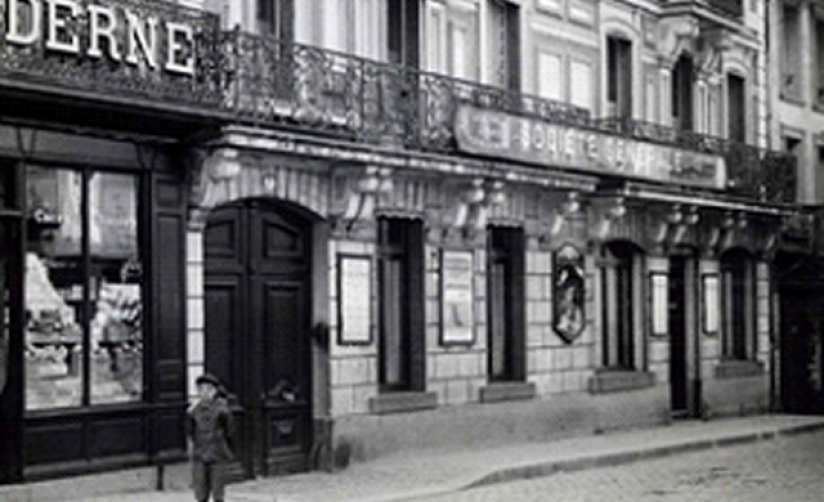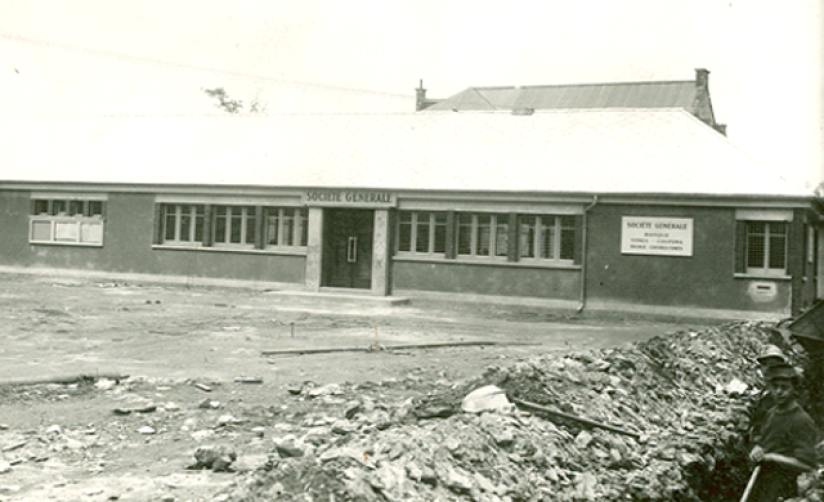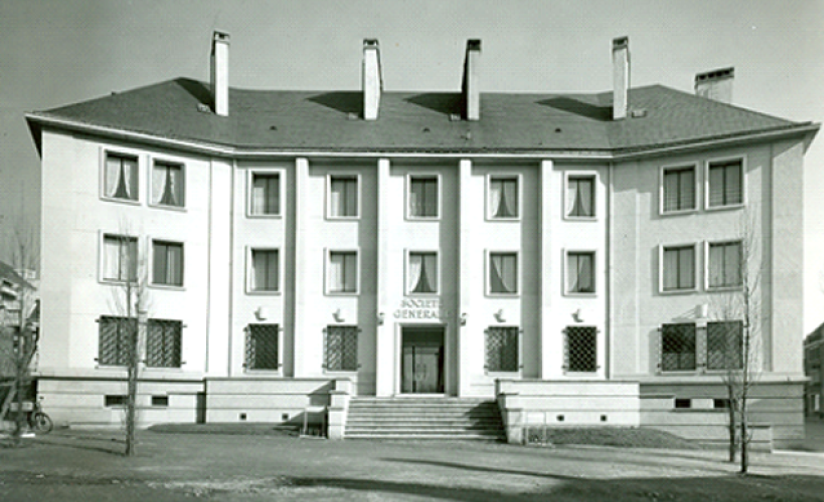75th anniversary of the D-Day landings
To mark the 75th anniversary of the D-Day landings in Normandy, discover the history of the Saint-Lô branch thanks to exclusive archives.
A translation of an account of the June 1944 bombings by Mr Harster, Saint-Lô Branch Manager
“Baudre, 16 June 1944,
I would like to describe the situation at the Saint-Lô branch following the opening of the 2nd front.
During the afternoon of Tuesday 6 June, the town of Saint-Lô suffered a small airborne attack (train station and power plant) that caused no major damage. That same evening around 8 pm, 18 flying fortresses attacked the centre of the town, causing serious damage. A large bomb fell some 50 metres from our bank branch, shattering our building’s windows and destroying the skylight above the Securities office. Around 9 pm, I wandered round the affected parts of town and observed the enormous damage this attack had caused. The Banque de France building had notably in large part collapsed. All its staff were still there at this late hour to find a cash irregularity, and suffered injuries of various levels of severity, but the Director’s mother and maid were killed instantly. As soon as I got back to our bank branch, I took all of my family, the caretaker’s family and Mrs. V., wife of the Cherbourg branch manager, a total of 12 people, into the branch’s shelter, i.e. the vault, to spend the night there.
At around 1 in the morning during the night of 6 to 7 June, our town – and in particular the area around our building – suffered a heavy bombardment by a substantial number of flying fortresses. The bombs rained down continuously for three quarters of an hour, and it is hard to describe how harrowing it was for us all down in the vault, which was buried by the first large bomb that landed on the main wall at the back of our building, this wall then collapsing in front of the door to the vault. Smoke and thick dust invaded our shelter from the start, and we would have been asphyxiated if we hadn’t taken the precaution of bringing reserves of water in jugs. In vain, we attempted to break out of our shelter via the armoured door that was completely blocked by the remains of the collapsed wall, but then a large bomb fell barely two metres away and partially cleared the blockage in front of the vault door.
After almost half an hour of intense effort, I managed to get out of the shelter from the top of the door and pull the other 11 occupants by their arms over two metres of rubble and out of the shelter one by one via the small slit in the armoured door. Our building and the entire neighbourhood were in flames, and – despite the fact that the intense bombing was still continuing – I ordered the survivors to head into the countryside. Exhausted by the efforts I had made to free the people entrusted to me, I briefly passed out and was unconscious for an unknown period of time. When I came to, lying in the stairwell of the building that had thus far remained intact, the entire upper part of our building was in flames, and I too quickly fled into the surrounding countryside.
Essentially, the entire town of Saint-Lô has been destroyed and there are barely fifty houses still standing on the edge of town – the centre is unrecognisable, and it was hard to find – three days after the bombing – where our bank once stood. The vault was still intact and, with the help of one of our customers, three days ago I was able to clear a passage inside and observe the resulting damage. Fire raged throughout the town for over a week, and caused further damage because of the heat. Indeed, the plaster on the ceiling and walls had come off, as had the ledges of some larger safes. It was impossible for me to shut the main entrance door, which has been blocked since Tuesday evening following the collapse of the main wall when it was hit by the first bomb of the second bombing raid during the night of Tuesday to Wednesday. However, using explosive material found in the brick and cement tiled room at the front, I was eventually able – it was at least 40° in the room – to lock the second door (iron bars) to keep everything inside safe from looters.
All of the documentation, typewriters and accounts from Saint-Lô and Cherbourg were put in the vault when we closed on Tuesday evening, so it will be fairly easy to piece together our accounts. However, all the archives were destroyed by fire, as was the furniture belonging to the bank branch and the building’s tenants. We only escaped with the clothes on our backs.
So, to summarise, the town of Saint-Lô having been completely destroyed and made uninhabitable, at the current time it would be impossible to simply move the branch’s services to another building. Furthermore, given that the battle line is just a dozen kilometres from here, we are likely to be evacuated to other towns in the south of the department.
Signed by Mr. Harster, casualty of Saint-Lô”.

The temporary facilities in 1945-1946
Translation of the written account of the Societe Generale Building and Equipment Services department’s visit to the Saint-Lô office
“22 May, 1945.
Accompanied by Mr Harster, on 22 May we visited the Saint-Lô Office and met the new office manager, Mr Moreau.
The temporary facilities are wholly inadequate; they are located on the very edge of town; indeed it is just about the last house before the open countryside.
The employees are working in difficult conditions within a single room that lacks a counter, whilst the Office Manager has a very narrow room.
It would appear that the Coutances branch was very slow to carry out the move to the new temporary premises. In the months that followed the bombing of the town, believe us it would have been possible to find a building in the town centre that had suffered little damage and was easy to repair.
We know that there were a few such opportunities, which were all quickly seized by shopkeepers or public authorities.
Amongst the remaining solutions that now need to be looked into are either the construction of a hutment on one of the sites designated by the Ministry for Reconstruction or the search for a building that is still standing.
The town’s appearance has not changed since the bombing; the streets have been cleared of debris, but the houses that were damaged or destroyed have not been touched, and it is truly shocking to see all these ruins and walls charred by fire. Life only appears to be getting back to normal extremely slowly, and there is virtually no traffic in town.
Mr Moreau, who was previously at the Le Mans branch, only arrived in Saint-Lô in early May. He found a very difficult situation, an inadequate workforce comprising 1 principal member of staff, 1 sales rep, 1 cashier and 2 female employees. Another employee was recently hired.
Mr Moreau says that 2 more employees are needed. Mr Harster has promised to send him two agents from Coutances within the next 5 or 6 weeks: the Portfolio Manager and the Chief Accountant, both of whom wish to return to Saint-Lô.
The office’s services are considerably behind schedule. No Securities have been sent out since the bombing.
It would appear that Mr Depaigne, the principal member of staff, during the few months he has been managing things, has not done anything useful to improve the situation, which was obviously a particularly difficult one.
Mr Moreau seemed fairly disheartened by the numerous major difficulties facing him in his new duties. Thus far he has been unable to find any lodgings except in extremely precarious conditions, and his two meals cost him an average of 120 francs a day. He has requested that the Personnel Department consider granting him a special allowance.
Amongst the other issues we observed during our visit was that of printed matter. Mr Moreau has provided us with an urgent request for printed material and supplies. It would be fitting to send him advances as quickly as possible via the swiftest method.
As well as the printed material and items indicated in this request, Mr Moreau needs current account statement sheets (500 sheets) with a binding and checking account statement sheets (1,000 sheets) with 2 bindings.
He also needs 1,000 cardboard boxes for various clients.
Lastly, he would be very grateful if he could be sent, as soon as possible, 3 tyres for standard 650 bicycles and, when possible, a new bicycle.”

The reconstruction of 1953
Translation of the address given by Societe Generale’s Managing Director, Maurice Lorain, at the inauguration of the new Saint-Lô branch on 6 March, 1953
“I still have vivid memories of your town, Gentlemen, because it brings to mind very moving professional memories.
I firstly remember a strange trip I took in mid-July 1944 to the Orne and Manche departments of Normandy. Everywhere I went, I saw that our Branches and Offices had been destroyed, but I also observed that our office managers, as instructed, had all immediately opened temporary facilities in nearby villages, in barns or classrooms, and were again providing services to their customers. Cash and securities deposits were pouring in. To take it all to Paris, we gradually loaded the banknotes and securities onto our van as space was made available by burning the charcoal. And I can now admit that we completed the shipment with meat and butter, which were useful in helping us feed our Parisian staff at the time.
Coming from Villedieu-les-Poëles, we found it difficult to approach Saint-Lô. The Coutances road was littered with holes caused by bombs, so we had to temporarily shelter our van behind one of the wooded embankments that cut through the Norman bocage and continue our journey by bike. In a village near Coutances, we finally found the office manager: he had received no post since the D-Day landings and was cut off from the rest of the country.
He was the one who told us about the tragic events in Saint-Lô: the town had been almost completely wiped out by the bombs and ensuing fires, and the ruins were peppered with hundreds of dead people. The Branch Manager at the time, Mr Harster, whose health had significantly deteriorated as a result of those events, had with great difficulty managed to free himself from the rubble of his security vault.
By this time, the American troops had already established a foothold in Saint-Lô and were preparing to make inroads towards Avranches that would enable them to begin moving their tanks towards Brittany, the Loire, the Sarthe and Paris. As I was leaving Coutances, I gave instructions for a bank branch to be re-established in Saint-Lô as soon as possible, once the military situation allowed it.
The difficult task of implementing these instructions was the responsibility of our new director, Mr Bonnet. Having first installed the management team in the Coutances branch, he was quickly able to ensure that a temporary branch was opened in Saint-Lô, on premises kindly made available to us by its owner. Then, at the end of 1945, he was given permission to build a temporary hutment that was completed in just a few months, enabling your town to again enjoy the management team and branch’s services
I was keen to return to Saint-Lô in May 1946 to inaugurate this hutment, and have emotional memories of the small and simple ceremony.
On the banks of the Vire River, at the foot of the Rock dominated by the remains of Notre-Dame Church, our brightly-coloured hut looked like a real house amongst all the ruins. This was Societe Generale’s first reconstruction, and prepared the way for all the others we were hoping to undertake. I’ll never forget the first flag fluttering on the first new roof nor the smell of new paint we had been deprived of for the last seven years…”
